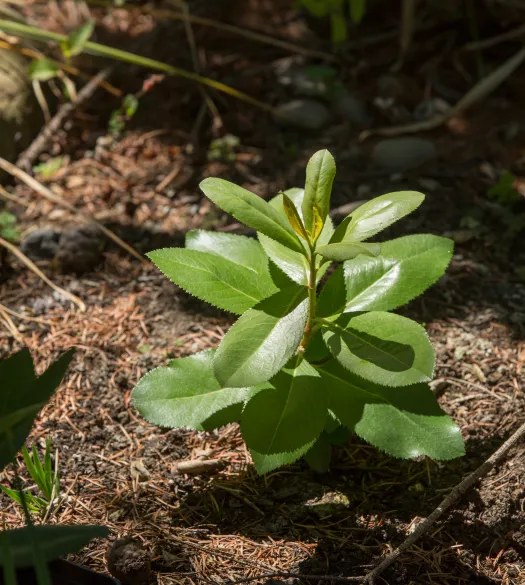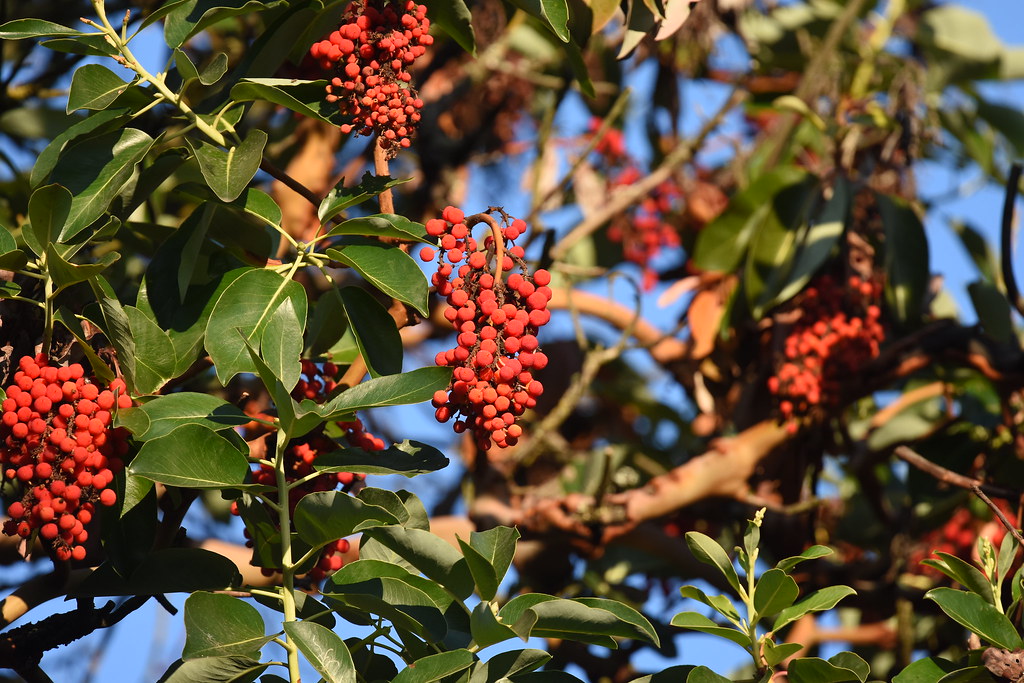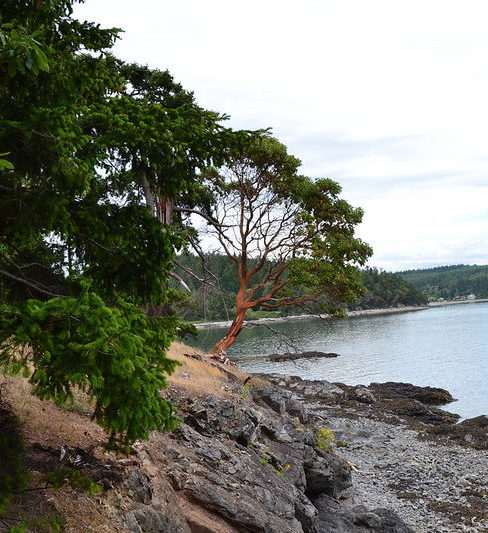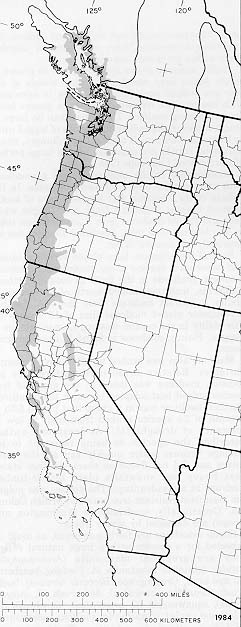Back in October 2023, I became acquainted with Alex Templeton, a West Seattle resident who lives adjacent to the Duwamish Head Greenbelt. On a drive-by of the neighborhood adjacent to the greenspace, I noticed Alex growing healthy baby madrones in his front yard. I knocked on his door and told him I was a fan of the tree.

The more I got to know him, we seemed to have a lot in common. He likes madrone. I like madrone. But he didn’t know about GSP’s efforts to replant and restore the tree to Seattle’s natural areas. Maybe I have been keeping this too much of a secret? While you may not notice our progress aboveground, I like to think we are mimicking the belowground nature of trees reaching out and growing authentic roots and powerful connections. Like my chance encounter with Alex.
Alex expounds upon Pacific madrone’s attributes as a native tree species, a stately broadleaf evergreen with smooth, cinnamon-colored bark and cheery reddish-orange berries in autumn, concluding with an optimistic sentiment: “What’s not to like?”.

Alex reflected on his first encounters with Pacific madrone in Seattle, particularly in the Magnolia neighborhood. He expressed an appreciation for these trees, noting the sparse yet beautiful presence of madrones along the bluff from Elliott Bay Marina to West Point Lighthouse. He also told me about his family’s longtime involvement in the Re-Tree Ballard urban reforestation initiative during the early 1990s – another link to my/our collective relationship with the trees. “My spouse and I planted several trees along Market Avenue NW in Ballard and did some post-planting watering of the dawn redwoods that still reside along 26th Ave. NW.” These legacy efforts like Re-Tree Ballard show us that what we pay attention to grows. And it reminds me that I have learned a lot from madrone in recent years.
Here are a few of my favorite fun facts, love notes and takeaways:
People have had a relationship with the genus Arbutus for a very long time. The tree features prominently in the origin story of the WSANEĆ people. It has many names such as ḰEḰEIȽĆ (WSANEĆ), and qʷuƛ̓əc, qʷuqʷuƛəc (S. Lushootseed). We also may know it as madrona, which comes from madroño after the Arbutus unedo or strawberry tree commonly found in Mediterranean locales and into southern Ireland. The etymology of the Arbutus literally means “arbor” or tree.
Some people may discriminate against the tree in certain locations because it defies the erect, straight-up-and down paradigm we see so often around us with other beloved Pacific Northwest trees. You won’t see the tree on approved street tree planting lists because of its tendency to grow bending towards the light in various directions, and some commonly referred to drawbacks as “prone to failure.”

The tree challenges our common conceptions about optimal health. Many madrones can endure a big suite of pathogen issues and some of the harshest growing conditions. It has been proven to be drought tolerant because of some of its inherent traits. For example, the tree is deeply rooted and it’s diffuse porous xylem structure provides a hydraulic safety margin during droughts we experience in a dynamic warming world. Additionally, their associations underground with ericoid mycorrhiza allow them to adapt and grow in super tough sites …all by themselves, but at times, with a little help from us.
It has been a long time since I updated the GSP Blog about Green Seattle Partnership’s efforts to learn more about, conserve and restore Pacific madrone. A lot has happened since the 2018 blog post where I outlined some steps for the “madrone recovery project.” We are proud to say this project has outgrown Seattle.

Slowly but surely, we have been growing the Arbutus ARME, which is a loosely-affiliated botanical and community-powered collective of people focused on Pacific madrone research, conservation, restoration and education. What started as a partnership between the Washington State University Ornamental Plant Pathology Program and Seattle Parks and Recreation’s Green Seattle Partnership has been incrementally growing into a range-wide effort–anywhere one finds the tree growing from what we now call British Columbia to Southern California.
The decentralized nature of the Arbutus ARME has allowed us to build off small projects and critical connections and relationships. Co-founder Marianne Elliott and I first got acquainted at the 2016 Future of the Pacific Madrone Symposium in Puyallup, WA. Flash forward a few years later, the GSP team at Seattle Parks and Recreation worked with forestry consultants on some forest assessment and planning as a complement to GSP’s Strategic Plan Update. A few of the recommendations from that work emphasized that we consider Pacific madrone trees and forests differently as climate-resilient species and special habitats. Ultimately, a collaboration was born with WSU Extension to focus on a ‘wish list’ for future research, projects and communications.
With limited time, but lots of collective enthusiasm, there always seems to be just enough time for madrone work the past few years. We have succeeded in putting together the Arbutus ARME website, which is a clearinghouse of madrone-specific information. There, one will find things to read about madrone basics, cultural uses, and most published scientific publications about the tree like its drought tolerance, adaptability, and water cycling by the tree.

We have provided all-day workshops in places like Camp Long and half day foot tours on Whidbey Island. During the height of the COVID pandemic, we went virtual with a variety of webinars and podcasts. Most recently, we attended the Oregon State University invitation to Roseburg, OR. There is already a wealth of knowledge and existing/evolving relationships across the species’ range. Hopefully, we have provided the groundwork and the infrastructure to grow a movement that is attune to the specific types of care the tree needs.
Importantly, what started as a paper survey grew into an iNaturalist community science project to record where we encounter madrones and their health condition. ‘We’ means everyone with a smartphone can contribute to developing a true range map for the species and monitor seasonal changes in tree health. Dozens of people have contributed hundreds of observations. This is a long-term project so please help us keep it going.
With the trust and incredible know-how of the Jefferson Greenhouse, Green Seattle Partnership has gone from planting essentially zero madrones five years ago to several hundred per year. Truth. It is hard to find in nurseries, so we often rely on local Seattle seed collection as well as collection of berries from the Puyallup common garden trial – focused on Wilsonville, Vaneta, and Zena (Willamette Valley) families that appear to be growing best in a recent study.
For those interested in growing madrone, Alex Templeton advises starting with basics outlined in WSU’s Puyallup Ornamental Plant Pathology program, emphasizing site selection on glacial sands, gravels, or rocky areas with good drainage and low moisture retention. He cautions about significant die-off during the seedling-to-sapling journey and advises against growing more than one can handle.
The Jefferson Greenhouse grows saplings from seeds, my teammates pot up plugs into pots, and we scavenge good-quality plant material from nurseries in the Puget Sound area. One will find these trees growing throughout Seattle’s natural areas. One highlighted project is the multi-year collaboration with Parks Planning and Development team which led to the installations we refer to as the Olmsted Parks and Boulevards Restoration Project. Prepped by crews in 2021, this upcoming year will be the second year of establishment care.
Below are some ways to stay connected with the madrone movement afoot:
Visit and share the Arbutus ARME website, which contains a wealth of madrone-specific information
All the latest madrone news, events and celebration can be found on the Arbutus ARME Instagram
Reach out with your madrone stories and specific questions by emailing us directly or joining the listserv https://www.arbutusarme.org/make-contact
Put that mobile device to use by contributing to the iNaturalist community science project
Keep imagining madrone in our future – there is a list of bright ideas found at our list of Needs & Opportunities

Tremendous!
So great to hear that this exquisite species is getting some love, thank you!
I’m so glad to see this article and all the resource links. I’ve loved and admired these trees since childhood. When the pandemic began, my husband and I went for a long walk in the urban forests near our home in Seattle’s Madrona neighborhood. We spotted a grand old tree that was suffering under a massive ivy infestation and decided to adopt it. We named it “Our Brutus” (corny take on “arbutus”), dug out the ivy growing at its base and planted some natives under its canopy. We return every few months to do maintenance. Our Brutus is doing much better.
My Q: would it be helpful for someone to go around to various healthy looking trees every autumn to collect the “seeds,” i.e. the little red berries that fall to the ground that time of year? I’d be willing to go on a scientific road trip around the region.